When is Ganesh Chaturthi?
Ganesha Chaturthi a famous Ganesh festival, also known as ‘Vinayak Chaturthi’ or ‘Vinayaka Chaturthi’, is a day when all Hindus celebrate one of the most popular deities, Lord Ganesh. This means the date will usually fall between August & September.
History of Ganesh Chaturthi (Ganesha festival)
Ganesh may also be known by the names Ganapati, Ekadanta, Vinayaka, Pillaiyar and Heramba.This remains one of the most celebrated holidays in the country, partly because Ganesh is one of the most popular deities for worship. His blessings are often invoked in religious ceremonies because he is the one who can remove all obstacles to success, especially when people start a new business or venture. Ganesh is known as the giver of luck and one who can help avoid natural disasters.
How is Ganesha Chaturthi celebrated?
In certain parts of India, such as Andhra Pradesh and Maharashtra, the festival is celebrated for ten days and is a public event. Elsewhere, it can be celebrated in homes where hymns are sung, and offerings are made to Ganesh. Sweets are a common offering because Ganesh was fond of them, according to Hindu legend.
On the day of the festival, clay idols of Ganesha are placed in homes or decorated tents for people to view and pay homage to.
Foods that Lord Ganesha loves
Modaks & Ladoos, whether steamed or fried, hold significant cultural and religious importance in Hinduism. They are considered to be Lord Ganesha’s favourite sweet, and offering modak during Ganesh Chaturthi is believed to bring blessings and good fortune.
The ten-day Ganesha Chaturthi festival is here, and the festive fervour is in the air. Lord Ganesha’s love for sweet treats makes the festive feast more enjoyable.
5 Modak Varieties
Coconut Modak
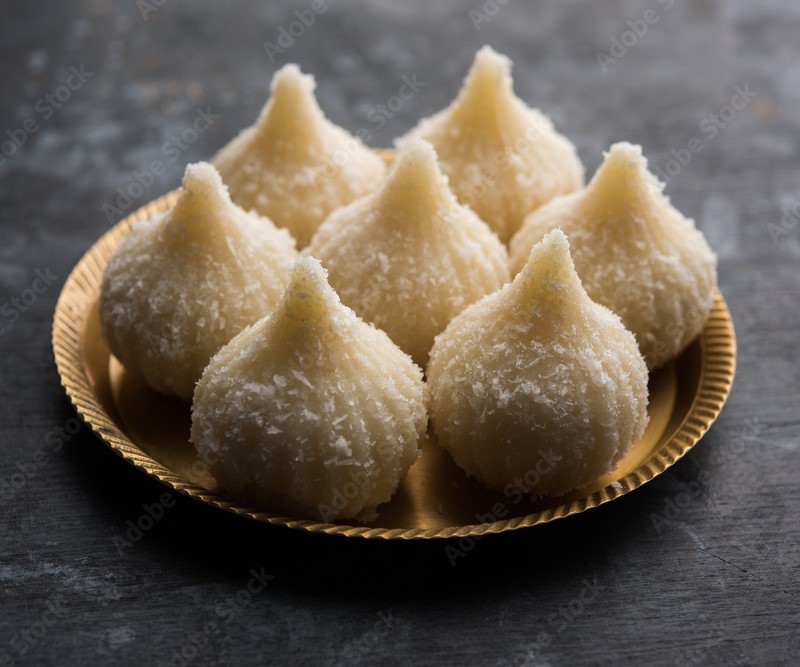
A popular dessert Modak from Maharashtra that is widely consumed during the Ganesha Chaturthi festival, modaks are now made in many parts of the country.
Ingredients –
For the filling:
- 1 cup shredded coconut
- 1 cup jaggery
- A pinch of nutmeg
- A pinch of saffron
For the shell:
- 1 cup of water
- Two teaspoons of ghee
- 1 cup of rice flour
How to make Modak
Prepare the filling:
- Heat a pan, and add grated coconut and jaggery.
- Stir for about five minutes. Add nutmeg and saffron, and mix well.
- Cook for another five minutes and set aside.
Preparation:
- Boil water with ghee in a deep vessel. Add salt and flour. Mix well.
- Cover the bowl and cook until half has been done.
- Spread some ghee on the bottom of a steel bowl and knead it well while the dough is still hot.
- Now take some dough, roll it into a ball, flatten it well, and shape the edges into a flower pattern.
- Place the dumplings in a muslin cloth and steam for 10-15 minutes. Serve.
Mawa Modak | Khoya Modak
Mava modak is a traditional Indian sweet delicacy, often prepared during festivals like Ganesh Chaturthi, which is dedicated to the elephant-headed Hindu deity Lord Ganesha. This sweet is a favorite of Lord Ganesha and is offered to him as a form of reverence.
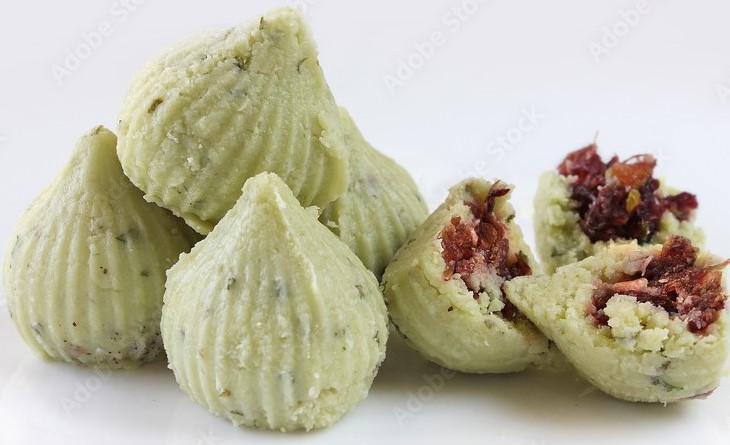
Ingredients:
- Mava (Khoya): Mava is the key ingredient in this sweet. It is a dense, dried milk solid obtained by slowly evaporating milk over low heat until most of the moisture is removed. This gives mava its distinct texture and flavor.
- Sugar: Sweetness is added using granulated sugar, which blends with the mava to create a delectable filling.
- Ghee: Clarified butter, known as ghee, is used to bind the ingredients together and impart a rich, buttery flavor.
- Cardamom Powder: This fragrant spice is added to enhance the flavor profile and aroma of the mava modak.
- Chopped Nuts (Optional): Some variations of mava modak include chopped nuts like almonds, cashews, or pistachios for added texture and crunch.
Preparation:
- The process starts by softening the mava in a pan over low heat. It is then mixed with sugar, ghee, and cardamom powder until a smooth, well-incorporated mixture is formed.
- If using, chopped nuts are added to the mixture at this stage for added texture and flavor.
- The mixture is then allowed to cool slightly, making it easier to handle.
- It is then shaped into small, cone-like dumplings using a modak mould or by hand. The modak mould leaves an intricate pattern on the surface of the sweet.
- The modaks are allowed to set, and they retain their distinctivCe shape.
Chocolate Modak
The dominant flavor of a Chocolate Modak is, of course, chocolate. It boasts a rich, deep cocoa taste, which can vary in intensity depending on the type and quality of chocolate used. The sweetness level is balanced to enhance the overall taste, providing a delightful contrast to the slightly bitter notes of the cocoa.

Ingredients:
- Chocolate (dark, milk, or white, depending on preference)
- Sweetened condensed milk or sugar for added sweetness
- Optionally, nuts like almonds, cashews, or pistachios for added crunch and flavor
- Ghee (clarified butter) for texture and richness
Preparation:
- Melt the chocolate in a double boiler or microwave, ensuring it reaches a smooth, lump-free consistency.
- Incorporate sweetened condensed milk or sugar to adjust the sweetness level to taste.
- If desired, add chopped nuts for additional texture and flavor.
- Allow the mixture to cool slightly, enabling it to be shaped into the characteristic conical form.
Fried Modak
The fried modak has a unique combination of textures and flavors. The outer shell is crispy and golden, offering a satisfying crunch, while the inner filling is soft, sweet, and fragrant due to the jaggery and cardamom. The grated coconut provides a chewy texture, and the nuts, if included, add a delightful crunch.

Dry fruit Modak
Dry fruit modak is a delectable Indian sweet that is a variation of the traditional modak, which is often offered to Lord Ganesha during the festival of Ganesh Chaturthi. This version is particularly popular for its rich and nutty flavor. Here’s a description of dry fruit modak:

Besan Ke ladoo

An Indian dessert is usually made during festive times. You can make this ladoo on special occasions and whenever you want a light Indian sweetness.
Ingredients
- 2 cups gram flour
- 1/2 cup ghee
- 3/4 cup sugar, powdered
- 1/4 teaspoon green cardamom, powdered
- for garnish almonds, blanched
How to make besan ke ladoo
- Melt ghee in a kadhai (wok) and add gram flour. Fry on low heat. It takes about 30 minutes for the flour to cook through, and it will be pasty when done.
- The color should be light brown. Turn off the heat and let the mixture cool completely. If it does not cool completely, it will become moist after adding the sugar. In the final stage, keep it pressed a little longer to make the surface smooth.
- Decorate the top of each ball. Serve.
Boondi Ladoo
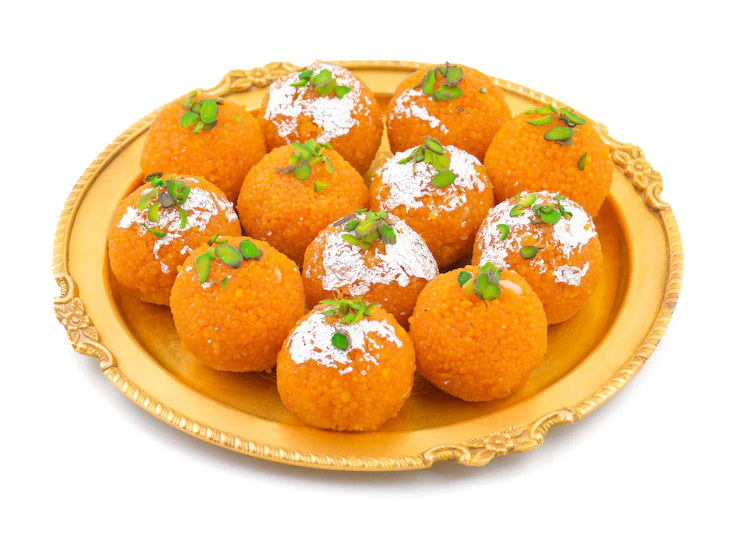
You can prepare this easy and free recipe for sinfully delicious ladoos at home for your next festival or puja.
Ingredients
- 500 grams of flour
- 1 liter of water or milk 750 g of ghee
- 750 g of sugar
- 3 1/2 cups of water
- 10-12 drops of orange color
- 10-12 saffron flakes, soaked
How to make boondi ladoo
- Make a thin dough from gram flour and water or milk. Heat the ghee in a pan.
- Fill the fryer or colander halfway with the batter.
- Place it on the pan and pour the boondis in the hot ghee by hitting the strainer on the side of the pan, lift and hit again. This process should be completed very quickly. Prepare round balls with wet hands.
Til Ladoo

These ladoos made Indian feasts. You can make these ladoos on special occasions and also whenever you want to have a light Indian sweetness.
Ingredients
- 1 Cup Jaggery
- 1/2 cup toasted sesame seeds
- 1 spoon of Ghee
- 1 tsp cardamom powder
- 1 tablespoon of almonds
How to make til ladoo
- First, toast the sesame seeds in a pan and let them cool. Then put the wok on gas and heat it by adding ghee.
- Add jaggery to it and let it dissolve completely then slow down the flame.
- After the jaggery dissolves, add the sesame seeds, cardamom powder, crushed almonds and cashews and mix well. Keep these laddoos in an airtight container and enjoy
Coconut Ladoo
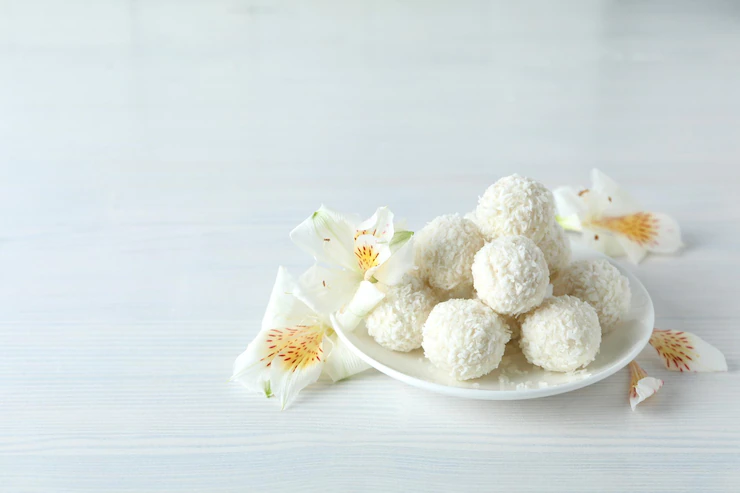
One of the Indian sweet recipes that can be easily prepared for any festival.
Ingredients
- 1/2 cup of Khoya
- 1 teaspoon Ghee
- 10-15 cashews
- 10-15 Nose Almonds
- 1 1/2 cups desiccated coconut
How to make coconut ladoo
- Take the khoya in a pan.
- Fry it well so that it dissolves and forms a paste.
- Now put some ghee in a pan and fry the cashew until golden.
- Next are the cashews, take the almonds and fry until golden.
- Now put desiccated coconut in the pan.
- Fry until light brown and add condensed milk.
- Mix them well to make a thick paste. Roll the coconut balls and serve
Kalakand

This is a simple and delicious sweet for special occasions and Indian festivals like Ganesha Chaturthi.
Ingredients –
- Whole milk
- Lemon juice:
- Condensed Milk
- Flavors
How to make Kalakand
- Add 6 cups (1.4 liters) whole milk to a heavy-bottomed pan. Set the heat to medium high.
- Stir frequently and let the milk come to a boil. Then turn off the heat.
- Now start adding the lemon juice, 1 tablespoon at a time, stirring gently after each addition.
- At one point the milk is completely curdled and the whey is separated. In order for the milk to coagulate completely. I used a total of 2 tablespoons + 1 teaspoon of lemon juice.
- After it hardens, cut the kalakand into pieces. I got 16 pieces of kalakand from this mixture. Keep refrigerated.
Mawa ladoo
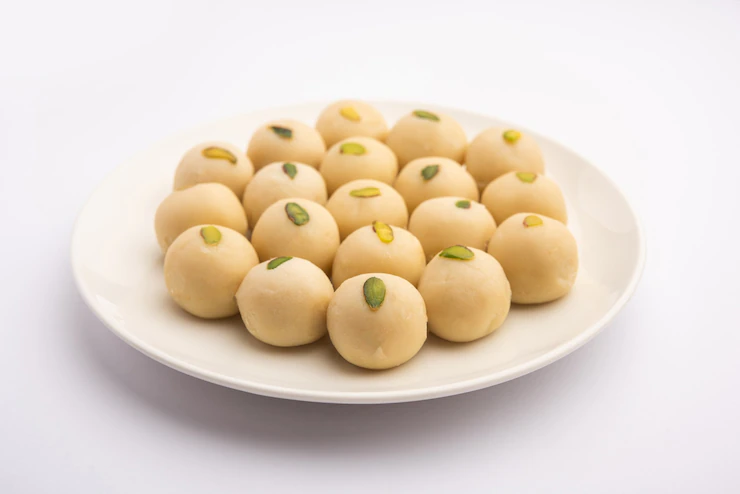
Super simple and tasty Indian sweet balls made from semolina, mawa (milk powder), cardamom and nuts.
Ingredients
- 1 cup Mawa/Khoya, crumbled
- ½ cup powdered sugar
- ½ spoon Ghee
- ¼ cup dried fruit/nut mixture, chopped
- 4 tablespoons of desiccated coconut
How to make mawa ladoo
- Heat the ghee in a non-stick pan then add mawa and cook for 2 minutes. Continue mixing.
- Add the sugar and cook for another 3-4 minutes. Remove from heat and let cool completely.
- Grease your hands with ghee and roll it into smooth balls after that flatten and make a hole in the middle. Let it set at room temperature and serve.
Shrikhand

This delicious dessert is enjoyed all over India, often offered as prasad in temples during pujas and many other festive occasions such as Ganesh Chaturthi.
Ingredients
- 1 1/2 cups dashi
- 1/4 cup sugar, powdered
- 1/2 tsp cardamom powder
How to make shrikhand
- Place the dahi in a colander lined with a thin tea towel and drain the excess water. It takes about 1 hour, depending on the richness of the dahi.
- Transfer the drained dahi to a bowl; add the sugar, half the cardamom, and mix well until smooth.
- Transfer to a serving bowl and garnish with remaining cardamom powder.
- Let it harden in the fridge, chill for at least 2 hours and serve.
Makhana Kheer

It’s perfectly rich and creamy sweet with a deliciously irresistible flavor! This makhane ki kheer is mostly prepared during Hindu festivals.
Ingredients
- Machine
- Sugar
- Milk
- Saffron and Cardamom:
- Cashew nuts
How to make makhana kheer
- Pour the milk into a deep saucepan with a thick bottom over medium heat and bring it to a boil. Meanwhile, keep stirring to prevent the milk from burning and sticking to the bottom of the pan.
- At the same time, on another stove, heat the ghee in a pan over medium heat. Once you’ve roasted the cashews until golden brown, remove them to a bowl.
- Also add the prepared makhana.
- Let it boil for 4-5 minutes.
- Then add sugar and let it boil for 2-3 minutes
- Garnish with fried cashews and raisins.
FAQ
Q.) What Prasad can be offered to Ganesha?
Lord Ganesha likes modak, so it seems reasonable that one of his names is Modakpriya.
Q.) What is Lord Ganesha’s favorite fruit?
Although an array of fresh and seasonal fruits are offered to Lord Ganesha as bhog, God’s love for elephant-headed bananas is no surprise.


You’re so awesome! I don’t believe I have read a single thing like that before. So great to find someone with some original thoughts on this topic. Really.. thank you for starting this up. This website is something that is needed on the internet, someone with a little originality!